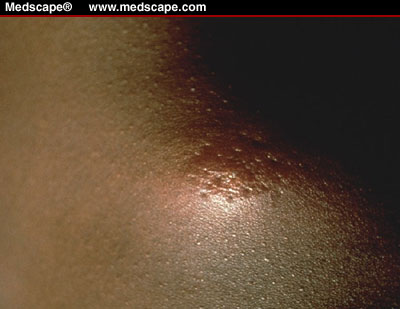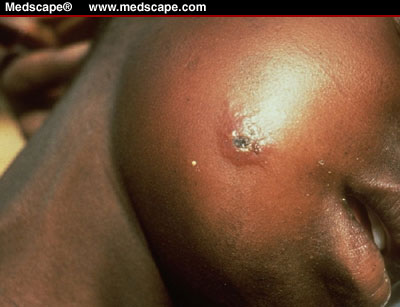Recently a child who has cutaneous anthrax originally received a
diagnosis of spider bite. Few US clinicians have ever seen a case of cutaneous
anthrax. While it is common in developing countries, especially in the Middle
East, central and southern Asia, and sub-Saharan Africa, cutaneous anthrax is
extremely rare in the United States.[1] Until the recent outbreaks, the last
reported US case had been in August 2000,[2] when a North Dakota man noticed a small
bump on his cheek a few days after burying some dead cows infected with
anthrax. The 2000 case was the first since 1992.
The infection usually appears on exposed areas such as the face,
neck, hands, and arms. The initial lesion is a small, pruritic macule or
papule, which then enlarges to form an ulcer that may be surrounded by vesicles
draining a clear or serosanguinous fluid.[3] A thick, black eschar surrounded by
erythema and edema follows. The eschar dries and falls off in 1-2 weeks, and
usually doesn't leave a scar.
Diagnosis is made by culture or smear. Without treatment, the
mortality rate for cutaneous anthrax can be as high as 20%; with antibiotic
treatment it is less than 1%.[2]
To browse the Dermatology Atlas and its 3000 other images, go to http://www.medscape.com/LII/DermAtlas/index.cfm
References
- Casken
H, Arabaci F, Abuhandan M, Tuncer O, Cesur Y. Cutaneous anthrax in eastern
Turkey. Cutis. 2001;67:488-492.
- Centers
for Disease Control. MMWR Weekly. Human anthrax associated with an
epizootic among livestock -- North Dakota, 2000. August 17, 2001;
50:677-680.
- Inglesby
TV, Henderson DA, Bartlett JG, et al. Anthrax as a biological weapon:
medical and public health management. JAMA. 1999;281:1735-1745.


Edward E.
Rylander, M.D.
Diplomat American
Board of Family Practice.
Diplomat American
Board of Palliative Medicine.